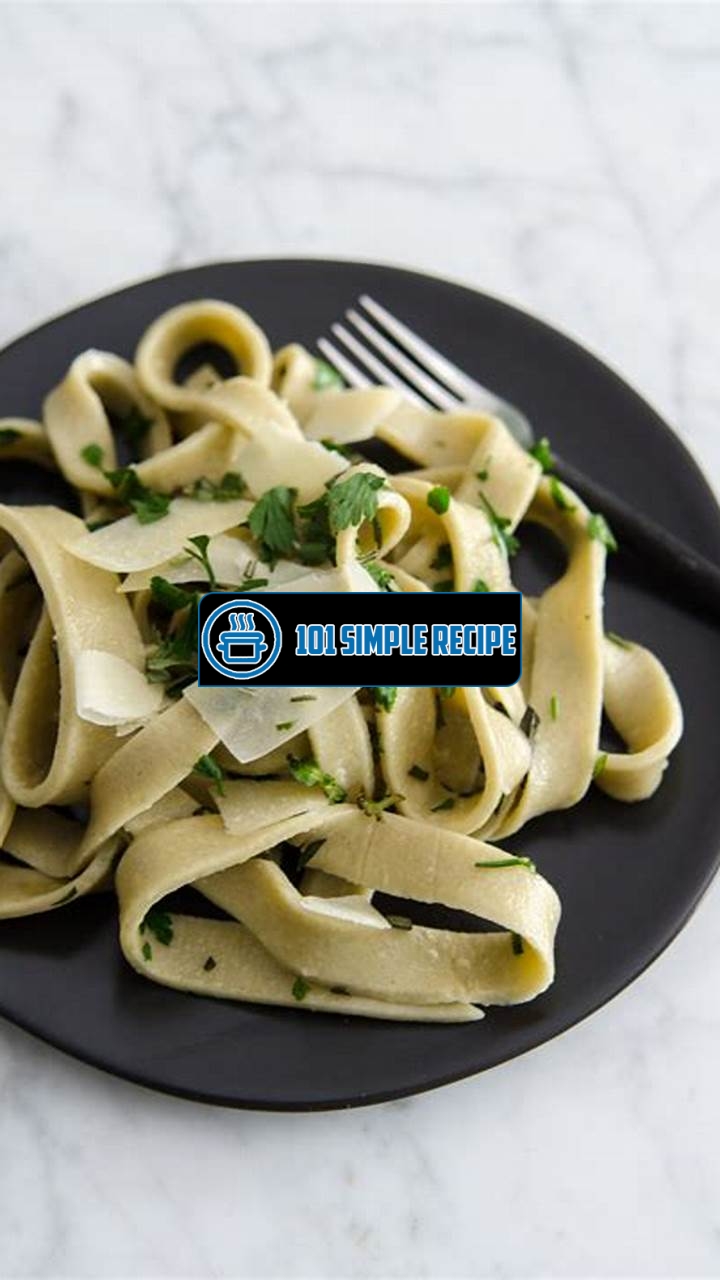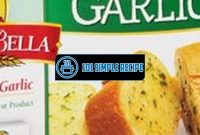Are you a pasta lover who is also following a gluten-free diet? Look no further! We have the perfect recipe for you: deliciously flavored gluten-free homemade pasta. ✨ There is something truly satisfying about a plate of fresh pasta, and now you can enjoy it without the worry of gluten. Whether you have celiac disease or simply choose to avoid gluten, this homemade pasta recipe will fulfill your cravings and delight your taste buds. The best part? You can easily customize the flavors to suit your preferences, making each batch a unique culinary experience. So roll up your sleeves and prepare yourself for a mouthwatering adventure into the world of gluten-free pasta! ️

Understanding Homemade Gluten Free Pasta
Making homemade gluten-free pasta is a rewarding experience that allows you to enjoy delicious pasta even if you have dietary restrictions. Gluten-free pasta is made from alternative flours that do not contain gluten, such as rice flour, almond flour, or corn flour. By understanding the process of making homemade gluten-free pasta, you can create a variety of tasty dishes that everyone can enjoy.
To start, you will need a gluten-free flour blend. This mixture combines different gluten-free flours to create a texture and taste similar to traditional pasta. You can make your own blend or purchase a pre-made one from the store. Some popular gluten-free flour options include a mixture of brown rice flour, potato starch, and tapioca flour. Experiment with different blends to find the one that suits your taste preferences.
Next, you’ll need to mix the flour blend with liquid ingredients to form a dough. Most homemade gluten-free pasta recipes include eggs or egg replacements, such as flaxseed meal or applesauce, to bind the dough together. You can also enhance the flavor by adding herbs, spices, or vegetable purees to the dough mixture. For example, you can incorporate spinach puree into the dough for a vibrant green pasta or add roasted garlic for a savory twist.
Once you have formed the dough, it’s time to roll it out and shape it into the desired pasta format. Gluten-free pasta dough can be more delicate and sticky compared to traditional wheat-based dough. To make it easier to work with, consider dusting your work surface and rolling pin with gluten-free flour. You can then roll the dough into thin sheets and cut it into your desired pasta shape, such as fettuccine, spaghetti, or ravioli.
When cooking homemade gluten-free pasta, it’s important to follow the instructions carefully. Gluten-free pasta tends to cook faster than regular pasta, so keep a close eye on it to avoid overcooking. Once cooked, gluten-free pasta should be drained immediately to prevent it from sticking together. Toss it with your favorite sauce or incorporate it into a flavorful pasta dish, such as a creamy carbonara or a zesty tomato basil pasta.
The beauty of homemade gluten-free pasta is that you can customize it to suit your dietary needs and personal taste preferences. Feel free to experiment with different flour blends, flavors, and shapes until you find the perfect combination. With practice and creativity, you can create delicious gluten-free pasta dishes that will impress both gluten-free and gluten-loving diners alike.
Why Choose Homemade Gluten Free Pasta
Homemade gluten-free pasta offers several advantages over store-bought options. Firstly, making your own pasta allows you to control the ingredients used, ensuring that you know exactly what goes into your dish. This is especially important if you have food allergies or intolerances, as you can avoid any potential trigger ingredients.
Additionally, homemade gluten-free pasta often has a superior taste and texture compared to pre-packaged alternatives. Commercial gluten-free pastas can sometimes be gummy or have a grainy texture. By making your own pasta, you can achieve a perfectly al dente consistency that rivals traditional wheat-based pasta.
Furthermore, homemade gluten-free pasta provides an opportunity to be creative in the kitchen. You can experiment with different flavors and add-ins, such as fresh herbs, spices, or vegetable purees, to create unique and exciting pasta dishes. This allows you to enjoy a wide variety of flavors while adhering to your dietary restrictions.
Finally, making homemade gluten-free pasta can be a fun and rewarding experience. It allows you to connect with your food on a deeper level and take pride in creating a dish from scratch. The process of making pasta can also be a bonding activity for friends and family, as everyone can get involved in rolling out the dough and shaping the pasta.
The Science Behind Gluten Free Pasta
Gluten is a protein found in wheat, barley, rye, and other related grains. It contributes to the elasticity and structure of traditional pasta, giving it its characteristic chewy texture. However, for individuals with celiac disease or gluten sensitivity, consuming gluten can lead to digestive issues, inflammation, and other health problems.
Gluten-free pasta is made by substituting gluten-containing flours with alternative flours that do not contain gluten. These alternative flours, such as rice flour or almond flour, lack the protein structure necessary for pasta dough to hold together. As a result, additional ingredients, such as eggs or xanthan gum, are often added to provide binding and elasticity to the dough.
When cooked, gluten-free pasta behaves differently than traditional pasta. It tends to absorb more liquid and cooks faster, requiring close attention to avoid overcooking. The absence of gluten also means that gluten-free pasta may not have the same stretchiness or chewiness as its wheat-based counterpart. However, with the right technique and ingredients, you can still achieve a satisfying texture and delicious flavor in your homemade gluten-free pasta.
Essential Ingredients for Homemade Gluten Free Pasta
To make homemade gluten-free pasta, you will need a few essential ingredients. Firstly, you will need a gluten-free flour blend, which can be a mixture of different gluten-free flours like rice flour, potato starch, and tapioca flour. This blend will serve as the base for your pasta dough.
Additionally, you’ll need liquid ingredients to bind and provide moisture to the dough. This can include eggs or egg replacements, such as flaxseed meal or applesauce. These ingredients help to create a cohesive dough that can be rolled out and shaped into pasta.
You can also add flavorings and seasonings to enhance the taste of your gluten-free pasta. This can include fresh herbs, spices, or vegetable purees. Get creative and experiment with different combinations to find your favorite flavors.
Lastly, don’t forget to have gluten-free flour on hand to dust your work surface and rolling pin. This will help prevent the dough from sticking and make it easier to handle and shape.
By having these essential ingredients readily available, you’ll be well on your way to creating delicious gluten-free pasta in the comfort of your own kitchen.
Getting Started with Homemade Gluten Free Pasta
Are you ready to embark on a culinary adventure and learn how to make your own deliciously flavored gluten-free pasta? Whether you have a gluten intolerance or simply want to explore new culinary horizons, making homemade pasta is a rewarding and satisfying experience. In this guide, you will learn the step-by-step process of preparing and rolling out gluten-free pasta dough, ensuring successful results every time.
Mixing the Gluten Free Flour Blend
The first step in creating your homemade gluten-free pasta is mixing the right flour blend. Gluten-free flours, such as rice flour or almond flour, are essential for achieving the perfect texture and taste. To create your flour blend, combine the different gluten-free flours in a bowl and mix them thoroughly. It’s important to ensure that the flours are evenly distributed to avoid any inconsistencies in the final product.
Note: Gluten-free flour blends can vary, so it’s recommended to follow a recipe or consult a reliable source to determine the best combination of flours for your homemade pasta.
Forming the Perfect Gluten Free Pasta Dough
Once you have prepared your flour blend, it’s time to form the pasta dough. In a large mixing bowl, combine the flour blend with a binder, such as xanthan gum or psyllium husk. These binders help to create structure and elasticity in the dough, compensating for the lack of gluten. Gradually add water or another liquid like eggs to the mixture, stirring continuously until a cohesive dough forms.
Important: Be cautious not to add too much liquid at once, as this can make the dough too wet and sticky. Instead, add small amounts of liquid gradually until the dough reaches the desired consistency.
Rolling and Shaping Gluten Free Pasta
After forming the dough, it’s time to roll it out and shape it into your desired pasta shape. This step requires a bit of patience and practice, as gluten-free dough can be more delicate and prone to tearing. Dust your work surface with gluten-free flour to prevent sticking and start rolling out the dough using a rolling pin.
Pro tip: When rolling out gluten-free pasta dough, it’s helpful to work in small batches and keep the remaining dough wrapped in plastic wrap to prevent it from drying out.
Once the dough is rolled out to your desired thickness, you can use a knife or a pasta machine to shape it into the pasta style of your choice, such as spaghetti, fettuccine, or ravioli. As you shape the pasta, remember to dust it with flour to prevent sticking and carefully transfer it to a baking sheet or drying rack to dry before cooking.
In conclusion, mastering the art of homemade gluten-free pasta requires attention to detail and a willingness to experiment. By following these steps and honing your skills, you can enjoy the satisfaction of creating flavorful gluten-free pasta dishes that will impress your friends and family. So, put on your apron and get ready to unleash your inner pasta chef!
Cooking Techniques for Homemade Gluten Free Pasta
Master the art of cooking gluten-free pasta to perfection, avoiding common pitfalls and achieving optimal texture and flavor.
Boiling Gluten Free Pasta: Dos and Don’ts
When it comes to boiling gluten-free pasta, following the right techniques can make all the difference in creating a delicious and satisfying dish.
Here are some dos and don’ts to keep in mind:
- Do: Use a large pot of water to cook your gluten-free pasta. This will give the pasta enough space to cook evenly and prevent it from clumping together.
- Do: Add salt to the boiling water before adding the pasta. This will enhance the flavor of the pasta and help it cook more evenly.
- Do: Stir the pasta occasionally while it’s cooking to prevent sticking.
- Don’t: Overcook gluten-free pasta. Follow the cooking time instructions on the package and taste-test the pasta to ensure it’s al dente.
- Don’t: Rinse the pasta after cooking. This will remove the starch that helps the sauce adhere to the pasta, resulting in a less flavorful dish.
Note: Cooking times may vary depending on the brand and type of gluten-free pasta you’re using. It’s always best to follow the instructions on the package for the most accurate results.
Sautéing Gluten Free Pasta for Added Flavor
Sautéing gluten-free pasta can add a delicious flavor and texture to your dish. Here’s how to do it right:
- Heat a skillet: Start by heating a skillet over medium-high heat. Add a small amount of oil or butter to prevent the pasta from sticking.
- Add the pasta: Once the skillet is hot, add the cooked gluten-free pasta. Spread it out evenly to ensure it cooks evenly and develops a nice golden color.
- Sauté: Cook the pasta for a few minutes, stirring occasionally, until it starts to crisp up slightly. This will add more flavor and make the pasta more enjoyable to eat.
- Season: Sprinkle your favorite seasonings or herbs over the pasta while sautéing to enhance the flavors even further.
Baking Gluten Free Pasta Dishes
Baking gluten-free pasta dishes can be a great way to create a flavorful and satisfying meal. Follow these steps for a successful baked pasta dish:
- Preheat the oven: Start by preheating your oven to the specified temperature in the recipe you’re following.
- Cook the pasta: Boil your gluten-free pasta until it’s just undercooked, as it will continue to cook in the oven.
- Prepare the sauce: While the pasta is boiling, prepare your sauce by combining your desired ingredients and seasonings. Be sure to use gluten-free ingredients to keep the dish safe for those with gluten sensitivities.
- Mix the pasta and sauce: Once the pasta is cooked, drain it and mix it with the sauce. Ensure that the pasta is evenly coated with the sauce for a delicious bite in every bite.
- Bake: Transfer the pasta and sauce mixture to a baking dish and bake it in the preheated oven for the specified time. This will allow the flavors to meld together and create a mouthwatering dish.
By mastering these cooking techniques for homemade gluten-free pasta, you can enjoy a delicious meal without compromising on flavor or texture. Whether you choose to boil, sauté, or bake your pasta, following these tips will help you achieve the perfect gluten-free pasta dish every time.
Creative Recipes and Variations with Homemade Gluten Free Pasta
Are you tired of the same old gluten-free pasta dishes? Elevate your culinary repertoire with these creative recipes and variations using homemade gluten-free pasta. From classic favorites to unique flavor combinations, these dishes will tantalize your taste buds and leave you wanting more.
Classic Italian Gluten Free Pasta Recipes
Italian cuisine is famous for its pasta dishes, and with homemade gluten-free pasta, you can enjoy these classics without worrying about gluten. Try making a traditional spaghetti carbonara with crispy bacon, eggs, and freshly grated Parmesan cheese. Or how about a rich and flavorful lasagna with layers of gluten-free pasta, savory meat sauce, and creamy ricotta cheese?
For a lighter option, toss your homemade gluten-free fettuccine with fresh cherry tomatoes, garlic, and basil for a quick and delicious pasta primavera. And don’t forget about the classic pasta alla vodka, where the tangy tomato sauce is complemented by a splash of vodka and a touch of cream.
International Inspirations: Asian-Inspired Gluten Free Pasta Dishes
Step out of your comfort zone and explore the world of Asian-inspired gluten-free pasta dishes. Swap traditional Italian flavors for bold and aromatic Asian ingredients that will add a unique twist to your homemade pasta.
Try making a spicy Thai-inspired peanut sauce to toss with your gluten-free spaghetti, garnished with fresh cilantro and crushed peanuts. Or how about a flavorful stir-fried noodles dish with gluten-free udon noodles, crisp vegetables, and a savory soy-based sauce?
For a taste of Japan, try making a gluten-free ramen bowl with homemade gluten-free ramen noodles, tender pork belly, and a rich and flavorful broth. Top it off with a soft-boiled egg, sliced green onions, and a sprinkle of nori for an authentic experience.
Exploring Flavorful Gluten Free Pasta Variations
When it comes to gluten-free pasta, the options are endless. Explore a range of flavorful variations that will take your homemade pasta dishes to the next level.
For a burst of freshness, try using zucchini noodles as a gluten-free alternative. Simply spiralize the zucchini, sauté it in olive oil, and toss with your favorite sauce and toppings.
If you’re looking for a heartier option, try incorporating gluten-free buckwheat flour into your pasta dough. The nutty flavor of buckwheat adds a delicious twist to classic pasta shapes.
For a unique and colorful dish, try making gluten-free beet pasta. The vibrant red hue of the pasta adds a visual appeal, and the earthy flavor pairs well with creamy sauces and robust meats.
With these creative recipes and variations, your homemade gluten-free pasta dishes will never be boring again. Whether you’re craving classic Italian flavors or want to explore international inspirations, there’s a world of delicious possibilities to discover.
Tips for Storing and Reheating Homemade Gluten Free Pasta
Learn how to properly store and reheat your homemade gluten-free pasta to maintain its freshness and taste for future meals.
Proper Storage Techniques for Gluten Free Pasta
When it comes to storing your homemade gluten-free pasta, there are a few key techniques to keep in mind. By following these tips, you can ensure that your pasta stays fresh and delicious:
- Use airtight containers: Store your gluten-free pasta in airtight containers to prevent moisture and air from spoiling it. Mason jars with tight-fitting lids or plastic containers with secure seals are great options.
- Label and date: It’s important to label your containers with the contents and date of preparation. This way, you can easily keep track of how long your gluten-free pasta has been stored.
- Refrigerate or freeze: Depending on when you plan to use your gluten-free pasta, you can choose to either refrigerate or freeze it. If you intend to consume it within a few days, refrigeration is sufficient. However, if you want to store it for longer periods, freezing is the best option.
- Divide into portions: If you’re making a large batch of homemade gluten-free pasta, consider dividing it into smaller portions before storing. This way, you can thaw and use only what you need, preventing unnecessary waste.
- Properly wrap: When freezing gluten-free pasta, wrap each portion tightly in plastic wrap or aluminum foil to prevent freezer burn. Then, place the wrapped portions in a freezer-safe bag or container for added protection against air and moisture.
Reheating Gluten Free Pasta: Dos and Don’ts
Knowing how to properly reheat your homemade gluten-free pasta is essential for maintaining its taste and texture. Here are some dos and don’ts to keep in mind:
- Do: Reheat your gluten-free pasta using methods that retain moisture, such as steaming, sautéing, or microwaving with a splatter guard.
- Do: Add a small amount of water or sauce to the pasta before reheating to prevent it from drying out.
- Do: Stir the pasta occasionally while reheating to ensure even distribution of heat.
- Don’t: Reheat your gluten-free pasta using methods that involve direct dry heat, such as baking or toasting. This can lead to further drying and loss of texture.
- Don’t: Overheat your pasta, as it can become mushy and lose its original texture.
Repurposing Leftover Gluten Free Pasta
If you find yourself with leftover gluten-free pasta, don’t let it go to waste! There are plenty of creative ways to repurpose it into delicious meals. Here are a few ideas:
- Pasta salad: Toss your leftover gluten-free pasta with fresh vegetables, herbs, and a flavorful dressing to create a refreshing pasta salad.
- Stir-fry: Sauté your pasta with assorted vegetables, protein of your choice, and your favorite sauce for a quick and tasty stir-fry.
- One-pot pasta: Cook your leftover gluten-free pasta along with some broth, vegetables, and protein to create a one-pot meal that’s both convenient and flavorful.
- Casserole: Combine your pasta with cheese, sauce, and any other desired ingredients, then bake it in the oven for a comforting gluten-free pasta casserole.
- Soup: Add your leftover gluten-free pasta to soups or stews for added texture and heartiness.
By following these tips for storing, reheating, and repurposing your homemade gluten-free pasta, you can enjoy its delicious flavors for multiple meals. Whether you choose to refrigerate, freeze, or repurpose your leftovers, you’ll be able to savor every bite without compromising on taste or quality.
Frequently Asked Questions
Thank you for taking the time to read our article on homemade gluten free pasta. Here are some frequently asked questions that may help with any lingering queries you have:
| No. | Questions | Answers |
|---|---|---|
| 1. | What’s the best gluten free flour to use for pasta? | The best flour for homemade gluten free pasta is a blend of rice flour, tapioca starch, and xanthan gum. This combination provides a good texture and elasticity. |
| 2. | Can I use a pasta machine to roll out gluten free pasta? | Yes, you can definitely use a pasta machine to roll out gluten free pasta. Just ensure you dust the dough with extra flour to prevent sticking. |
| 3. | How do I store homemade gluten free pasta? | To store homemade gluten free pasta, let it dry for a couple of hours, then place it in an airtight container or bag and keep it in the refrigerator for up to 3 days. |
| 4. | Can I freeze homemade gluten free pasta? | Absolutely! After drying the pasta, you can freeze it in an airtight container or bag for up to 3 months. Just thaw it in the refrigerator before cooking. |
| 5. | How long do I need to cook gluten free pasta? | Cooking times may vary depending on the type and thickness of the gluten free pasta. Generally, it only takes 8-10 minutes of boiling for al dente pasta. |
| 6. | Can I use gluten free pasta for any pasta dish? | Yes, you can! Gluten free pasta can be used as a substitute in any pasta dish, allowing everyone, including those with gluten sensitivities or celiac disease, to enjoy a wide range of pasta recipes. |
Thanks for Reading! Visit Again for More Gluten Free Delights!
We hope you found our article about homemade gluten free pasta helpful and inspiring. Whether you follow a gluten free diet or have someone in your life who does, making your own pasta from scratch can be both rewarding and delicious. By using simple ingredients and following our tips and techniques, you’ll be able to enjoy freshly made gluten free pasta anytime. Don’t forget to bookmark our page and visit us again for more gluten free recipes and culinary delights. Happy cooking!
Jump to Recipe
Homemade Gluten Free Pasta

Learn how to make your own gluten free pasta at home with this easy-to-follow recipe. Enjoy delicious homemade pasta without worrying about gluten!
- 2 cups gluten free flour
- 1/2 cup tapioca starch
- 1/2 teaspoon xanthan gum
- 3 large eggs
- 1/4 cup water
- 1 tablespoon olive oil
- 1/2 teaspoon salt
- In a large mixing bowl, whisk together the gluten free flour, tapioca starch, and xanthan gum until well combined.
- Make a well in the center of the dry ingredients and add the eggs, water, olive oil, and salt. Gently whisk the wet ingredients together, then gradually incorporate the dry ingredients until a dough forms.
- Transfer the dough to a lightly floured surface and knead for about 5 minutes, or until the dough is smooth and elastic. Cover with a clean kitchen towel and let it rest for 10 minutes.
- Divide the dough into 4 equal portions. Take one portion and flatten it with your hands. Using a rolling pin, roll out the dough into a thin sheet, about 1/8 inch thick.
- Cut the rolled out dough into desired shapes, such as fettuccine or spaghetti. Toss the cut pasta with some additional gluten free flour to prevent sticking.
- Bring a pot of salted water to a boil and carefully add the gluten free pasta. Cook for 8-10 minutes, or until the pasta is al dente. Drain and serve with your favorite sauce and toppings.
- Enjoy your homemade gluten free pasta!






